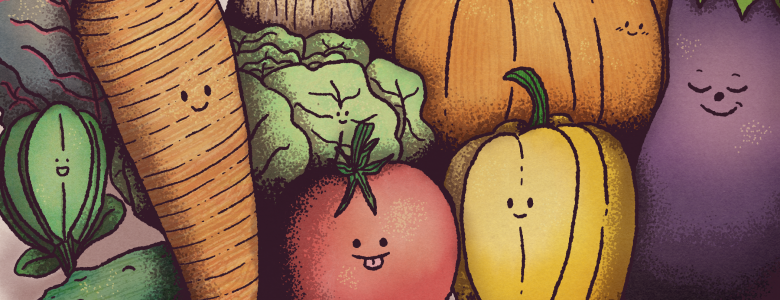April 30, 2021
Vegetables Aren’t Real

By: burgundy bug
A cartoonish illustration of common “vegetables”: red chard, spinach, cucumber, carrot, squash, lettuce, tomato, pumpkin, pepper, and eggplant
Source: Burgundy Bug
By now, we’ve all heard the age-old argument about whether tomatoes are a fruit or a vegetable. Although the U.S. Supreme Court ruled tomatoes were a vegetable for “tax purposes” in 1893, a botanist would tell you that vegetables aren’t real and that tomatoes are actually a berry.
While we’re at it, cucumbers, peppers, avocados, pumpkins, pomegranates, watermelons, oranges, lemons, limes, grapes, and bananas are all berries, too. Strawberries and raspberries, however, are not. They’re “accessory fruits.”
Okay, Back It Up — What Do You Mean Vegetables Aren’t Real!?
Despite the leafy green salad you may have had for lunch, you didn’t eat a single vegetable. Simply put, there’s no botanical classification of vegetables.
Rather, “vegetable” is a common term used to describe edible plants (or fruit) that aren’t sweet.
“‘Root vegetable’ is a kitchen category, not a botanical one,” explains a Penn State University article. Beets, celeriac, carrots, sweet potatoes, parsnips, and turnips are edible roots.
Onions, garlic, leeks — they’re edible bulbs. Potatoes are neither a root nor a bulb, they’re a tuber. Why? Because their stems are underground.
Asparagus, celery, and rhubarb are edible stems. Broccoli and cauliflower are edible flowers.
Beans and chickpeas are legumes, which are a type of simple, dry fruit, according to the University of Wisconsin. Peas fall into this category, as well.
So… Should I Stop Describing Foods as Vegetables?
Nah, do as you please. After all, you wouldn’t bite into a tomato the same way you would bite into a strawberry, would you?
But if you’ve ever asked yourself whether an avocado was a fruit or a vegetable, now you can rest assured knowing that it’s neither. Avocados are berries.
What’s the Difference Between a Berry and a Fruit?
Berries are still considered a “simple fruit.” They can have one seed or many seeds, but their main distinction from “pome” is their inner portions become “enlarged and juicy.” Those with hard, tough skins — such as pumpkins, squash, gourds, cucumbers, and watermelons — are classified as Pepo.
Citrus fruits are a berry, but they’re not a pepo. Instead, they’re classified as hesperidium, which have a leathery rind and partitions between each section.
Peaches, plums, cherries, olives, mangos, almonds (and a few other nuts) are drupes. These are fleshy fruits with a hard stone inside.
Pomes have an inner core (or ovary) surrounded by flesh, like apples or pears. They’re often considered an accessory fruit, which means some parts are derived from the ovary and others stem from the flower during maturation.
Accessory fruits also include strawberries, which are aggregate fruits. Aggregate fruits clusters of “ripened ovaries (fruits)” produced from a single flower. Blackberries and raspberries are also aggregate fruits.
Pineapples, breadfruits, figs, jackfruits, and mulberries, are multiple fruits, which are clusters of fruits produced by clusters of flowers. It’s worth noting that figs are also an accessory fruit.
In Conclusion
Whether you’re vegan, vegetarian, or run at the very mention of leafy greens, the natural world is far more complex and beautiful than comprehendible.
We encourage you to take a moment to appreciate the fruits of mother nature’s labors next time you order a side of veggies with your meal. But this doesn’t mean you should necessarily chase down your server and tell them their menu is wrong because “vegetables don’t exist.”
Subscribe to have Burgundy Zine content sent directly to your email inbox!
Interested in having content featured in an upcoming blog post or issue of The Burgundy Zine? Head on over to the submissions page!
For all other inquiries, please fulfill a contact form.


